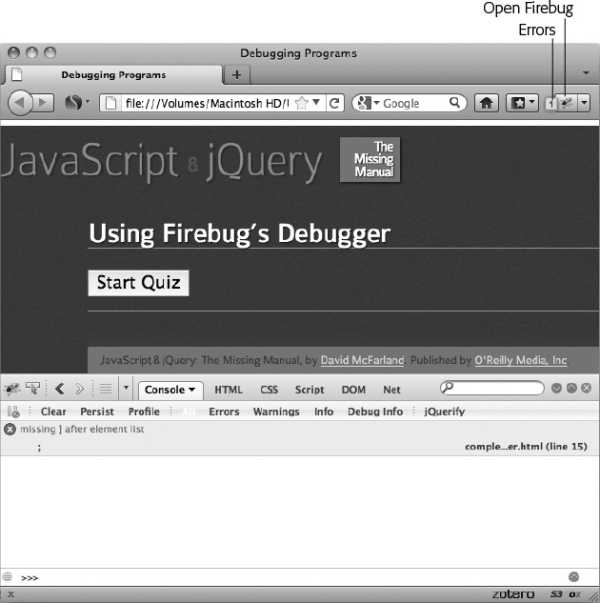
- FIREFOX FIREBUG JAVA SCRIPT DEBUGGER HOW TO
- FIREFOX FIREBUG JAVA SCRIPT DEBUGGER INSTALL
- FIREFOX FIREBUG JAVA SCRIPT DEBUGGER CODE
- FIREFOX FIREBUG JAVA SCRIPT DEBUGGER DOWNLOAD
- FIREFOX FIREBUG JAVA SCRIPT DEBUGGER FREE
require_once('FirePHPCore/fb.PHP') FB:: The Procedural API This is the format for calling static methods in your scripts. Require_once('FirePHPCore/') $firephp = FirePHP::getInstance(true) $firephp -> OO API with Static Methods
FIREFOX FIREBUG JAVA SCRIPT DEBUGGER CODE
In your script, you can use the following code block to create the FirePHP object ($firephp). I’m a lazy guy and because static methods are more terse and require less typing, that’s what I use. The OO API allows you to instantiate a Firebug object to use it or to call its static methods directly. I prefer the object-oriented techniques and I encourage you to use the same pattern as it is considered the most popular and most modern approach to building apps. One thing to note is that, just like PHP, which (at least for PHP4 and PHP5) is a “ pseudo object-oriented” language, you can use FirePHP in a procedural or object-oriented (abbreviated OO from now on) manner. This is the fun part where we start logging messages and reviewing the basic logging functions. And then just a general tip for Firebug/FirePHP users: it’s also a good idea to disable or suspend Firebug and FirePHP when you’re just browsing the web because they can really slow down some websites and web applications (such as Gmail, for example).
FIREFOX FIREBUG JAVA SCRIPT DEBUGGER HOW TO
You have to disable FirePHP when the site goes live or you will risk exposing sensitive information to anyone that has Firebug/FirePHP installed (we’ll talk about how to do this later down the article). Tip #2: don’t forget to disable FirePHP Logging when you go live It may sound complicated, but all you have to do is write ob_start() on the first line of your PHP script that you’re debugging. But first, I’d like to share two helpful tips I’ve learned: Tip #1: call ob_start()īecause the information is sent to Firebug in the HTTP Headers, you should activate the output buffering or you might get the “headers already sent error”. Once you’ve installed FirePHP, and included it in your web application, you are ready to debug and log data.
FIREFOX FIREBUG JAVA SCRIPT DEBUGGER FREE
This article is about using FirePHP, so I’ll let you handle the installation part (though feel free to ask in the comments – we’d be happy to help if you encounter issues).
FIREFOX FIREBUG JAVA SCRIPT DEBUGGER INSTALL
FirePHP can be a little tricky to install if you’ve just recently started learning about web development, but there’s good documentation out there about it. Installation of the three things above is a straightforward process.
FIREFOX FIREBUG JAVA SCRIPT DEBUGGER DOWNLOAD
If you don’t have all of the above applications installed on your machine, click on their link to learn about how to download them for your particular system. The official FirePHP site can be found via this web address: Christoph Dorn is the person responsible for creating FirePHP.Īs you might have guessed, you need three things to get up and running with FirePHP, they are: So, what is FirePHP?įirePHP is an add-on for an add-on: it extends the popular in-browser web development tool called Firebug with an API for PHP web application developers.įirePHP is free and easily attainable via the Mozilla Add-Ons section on the official Mozilla site. This makes FirePHP ideal not only for debugging your Ajax requests, but also your entire PHP codebase. This is where FirePHP helps, allowing you to log your debugging messages to the Firebug console.įirePHP doesn’t mess with your code (and it doesn’t require you to modify anything to trap errors): the messages you print are sent to the browser in the HTTP response headers, which is great when you’re using JSON or XML since it won’t break their encoding. When Ajax techniques became popular, developers faced a new problem: how can we debug Ajax requests and responses efficiently for complex web applications? If using a debugger was hard enough with the RESTful model, triggering an Ajax-specific request is a pain and a bit more difficult dumping logs and information pertaining to those Ajax operations had to be done using JSON or XML. You’ll learn the basics of leveraging Firefox in conjunction with Firebug and FirePHP to implement FirePHP libraries on web apps and logging messages in the Firebug console. This article shares an elegant, simple, and more maintainable way of debugging Ajax apps via the web browser (more specifically for the Mozilla Firefox browser).

Typically, there are two main ways of debugging server-side code: you can utilize an Integrated Development Environment (IDE) with a built-in debugger or log and perform your debugging processes in a web browser.


 0 kommentar(er)
0 kommentar(er)
